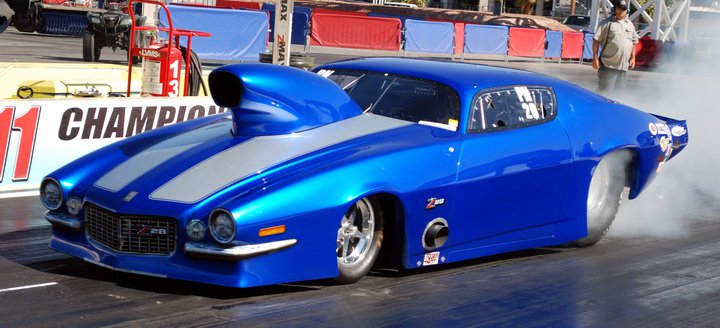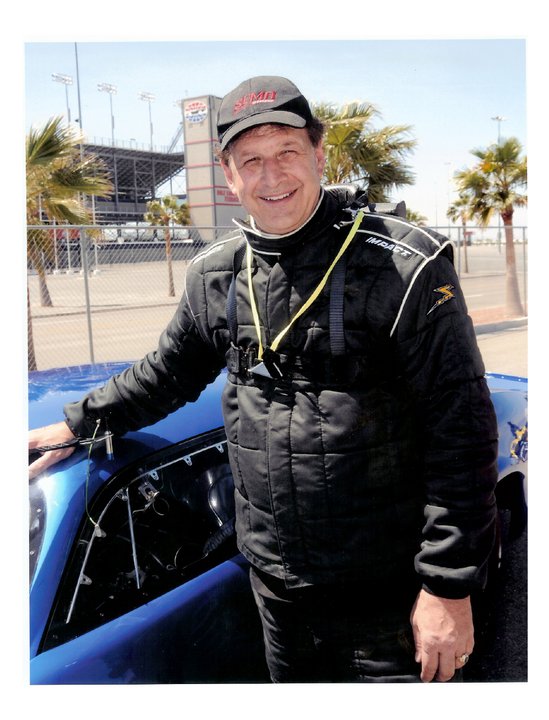LEPONE FINDS NEW FOCUS IN DRAG RACING
 Ever wonder what happened to Joe Lepone? Nothing – he's been here all along, just not Pro Stock.
Ever wonder what happened to Joe Lepone? Nothing – he's been here all along, just not Pro Stock.
Lepone, easily one of the biggest names in NHRA Pro Stock from the early 1980s through the mid-1990s, seemed to materialize out of nowhere last month when he wheeled Derrol Hubbard's Pro Mod '70 Camaro to a national record 6.10, 234.64 at the Division 7 points meet at Las Vegas.
Actually, Lepone has been going overseas, tuning and teaching people how to drive in Abu Dhabi, Qatar, and Kuwait, since about 2004, when he ran into engine builder Pat Musi at a track down south. "He asked me if I could make his car run better, and I told him yeah," Lepone says. "I'd never tuned a nitrous car, but I figured it couldn't be that different. After a couple of runs, we ran a 4.16 (eighth-mile), and then I started playing with the clutch and the nitrous. We made four hits one day and three the next and eventually ran a 4.04 with the first sub-1-second 60-foot time. I've always been a chassis guy and a clutch guy, and it really wasn't all that different from what we used to do in Pro Stock. There's one extra thing to make the car faster, and more dials and buttons, but it's the same concept it was Pro Stock."
 Ever wonder what happened to Joe Lepone? Nothing – he's been here all along, just not Pro Stock.
Ever wonder what happened to Joe Lepone? Nothing – he's been here all along, just not Pro Stock.
Lepone, easily one of the biggest names in NHRA Pro Stock from the early 1980s through the mid-1990s, seemed to materialize out of nowhere last month when he wheeled Derrol Hubbard's Pro Mod '70 Camaro to a national record 6.10, 234.64 at the Division 7 points meet at Las Vegas.
Actually, Lepone has been going overseas, tuning and teaching people how to drive in Abu Dhabi, Qatar, and Kuwait, since about 2004, when he ran into engine builder Pat Musi at a track down south. "He asked me if I could make his car run better, and I told him yeah," Lepone says. "I'd never tuned a nitrous car, but I figured it couldn't be that different. After a couple of runs, we ran a 4.16 (eighth-mile), and then I started playing with the clutch and the nitrous. We made four hits one day and three the next and eventually ran a 4.04 with the first sub-1-second 60-foot time. I've always been a chassis guy and a clutch guy, and it really wasn't all that different from what we used to do in Pro Stock. There's one extra thing to make the car faster, and more dials and buttons, but it's the same concept it was Pro Stock."
Lepone was a fixture on the NHRA tour from 1982 – the first year that NHRA dropped pounds-per-cubic-inch racing and adopted IHRA's 500-cubic-inch format – until 1990, and he finished in the top five three times. His biggest win came at the 1985 World Finals at Pomona, where he dropped perennial championship contender Frank Iaconio in the first round, world champ Bob Glidden on a holeshot in the semi's, and Bruce Allen, who was completing his first year in the Reher & Morrison car, in the final.
The Pennsylvania native made six other final-round appearances in NHRA competition from the 1983 Southern Nationals in Atlanta until the 1990 Heartland Nationals in Topeka, knocking horns with the biggest names of the era: Glidden, Shepherd, W.J., Allen, Iaconio, and Alderman. He went on to finish somewhere in the top 20 through 1995 and raced sporadically until the 2000 Mid-South Nationals in Memphis, where he made his final NHRA Pro Stock appearance.
Since Lepone, who now lives in North Carolina, took over tuning for and later driving for Hubbard's Palm Desert, Calif.-based DBarD Trucking operation, the car has gotten nothing but quicker, culminating in the 6.10, 234.64 A/PM record run at The Strip at Las Vegas. A week earlier the same track, Lepone had qualified for the NHRA Get Screened America Pro Mod field at the Big O Tires Nationals. The line-loc broke on the line in the first round of eliminations and he rolled the beams, advancing eventual event winner Leah Pruett, who was on seven cylinders that time and shut off to a 13.66.Then Lepone got an idea. "I asked Derrol, 'You ever set a national record?' He told me no, so we left the car there for another week and ran the points meet. We stayed for just one reason: to set record. We weren't even going to run eliminations because I didn't want to screw up anybody who was going for a points championship. The first run, it went a 6.15, the first leg of a new national record. We lost a qualifying session, so the only way to back it up was in eliminations. We were No. 1 qualifier with that run, and the guy I ran came over in the lanes and shook my hand and said I had him covered by four-tenths. I told him he didn't have anything to worry about. I didn't come right out and tell him I was going to red-light, but I'm a four-tenths driver and that's a five-tenths Tree. When he left, I put it on the limiter and stared at the bottom bulb, and it came up -.042 red."
 "It's a five-second car," Lepone says. "Everything's pretty much the same except when you go into high gear. It's like putting a Pro Stocker in second gear. When I first drove [Bill "Grumpy"] Jenkins' Pro Stock car in '82, the quickest I'd ever gone was a 9.16 in A/Gas, and I went 7.77 on the first run. This thing's moving, believe me, but as far as the speed goes, it's like when you go from 55 mph to 75 mph on the freeway or when you step up from any other kind of drag race car. You don't know how fast you're going until there's a problem."
"It's a five-second car," Lepone says. "Everything's pretty much the same except when you go into high gear. It's like putting a Pro Stocker in second gear. When I first drove [Bill "Grumpy"] Jenkins' Pro Stock car in '82, the quickest I'd ever gone was a 9.16 in A/Gas, and I went 7.77 on the first run. This thing's moving, believe me, but as far as the speed goes, it's like when you go from 55 mph to 75 mph on the freeway or when you step up from any other kind of drag race car. You don't know how fast you're going until there's a problem."Lepone credits an excellent team and supporting cast for the performance of the car.
"I have Darrol and the crew of Bob Wooton, Greg Holman and the awesome Pat Musi fuel injected power," Lepone added
Behind the wheel or under the hood, Lepone clearly has found a home in Pro Mod-style racing. To him, that's where it's at now anyway. "I don't see Pro Stock in NHRA much longer," he says. "I was offered a complete Pro Stock deal for next year, but I'm not doing it. I don't see the future in it. I mean, nobody ports heads anymore. You want to start your own engine program? Easy – steal somebody's engine guy, set up a shop, and you're in business. When I ran Pro Stock, it was Ford, Pontiac, Dodge, Chevrolet. There were banners everywhere. Now, Pontiac wins the championship and you can't even buy one. The Camaro is a joke in the wind tunnel, and there's no Cobalts, no Cavaliers."
 There's no fuel injection, either. "A carbureted engine with nitrous is ineffective, really," Lepone says. "There's so much nitrous going in there, so much pressure in the manifold, that the carburetor becomes ineffective. With fuel injection, you can trim cylinder to cylinder and you only need half the solenoids. Pro Stock is cookie-cutter racing now. I take nothing away from the people who are doing it, and look how tight the fields are these days, but there's no personality out there. There's no big-mouth Tony Christian or Joe Lepone around. I went to Charlotte and Indy as a spectator, and I was a little disheartened because when Pro Stock came up, the stands emptied. Pro Mod started running, and the stands filled back up again. It's because Pro Mod's one of the most diversified classes out there – blowers, turbos, nitrous."
There's no fuel injection, either. "A carbureted engine with nitrous is ineffective, really," Lepone says. "There's so much nitrous going in there, so much pressure in the manifold, that the carburetor becomes ineffective. With fuel injection, you can trim cylinder to cylinder and you only need half the solenoids. Pro Stock is cookie-cutter racing now. I take nothing away from the people who are doing it, and look how tight the fields are these days, but there's no personality out there. There's no big-mouth Tony Christian or Joe Lepone around. I went to Charlotte and Indy as a spectator, and I was a little disheartened because when Pro Stock came up, the stands emptied. Pro Mod started running, and the stands filled back up again. It's because Pro Mod's one of the most diversified classes out there – blowers, turbos, nitrous."For now, Lepone is more than content to tune some of the fastest nitrous cars in the world and drive one of them. He won't say what Hubbard's 2012 car will be other than that it "probably won't be something that weighs 2565 pounds [like this one]. When you're tuning guys' cars, it's great to see the 60-foot time drop from 1.03 to .997," Lepone says, "but it's better being in the car and feeling it for yourself. It takes meticulous concentration in there, and there's the responsibility, obviously. Everybody's work and Derrol's money is reflected in what the car does in those six seconds, but it's fun. Driving is a whole different kind of adrenaline. People ask me if I'm nervous. Why should I be? I choose my own destiny – I want to do this. They ask if I missed driving. I didn't until I started doing it again. It's cool to be signing autographs again, you know? Fans try to thank me, and I'm like, 'No, thank you.' -- without you I don't have a job."




































